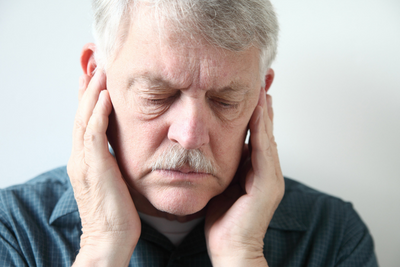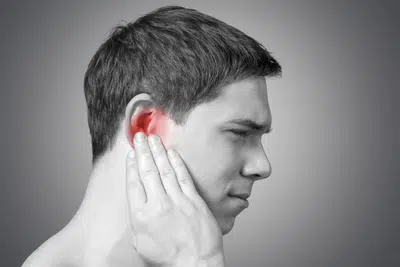Your eyes, spinal cord, brain and inner ears help regulate your ability to be in balance. As you move and change positions, your brain and vestibular system communicate with the muscles in your body to help you maintain your balance. When there is an issue with your brain, eyes, spinal cord and any component of your vestibular system, or with signal processing, dizziness, vertigo, and balance challenges often ensue.
Everyone experiences periodic dizzy spells and lightheadedness. These episodes usually cause a loss of balance which can lead to trips, falls, and injuries, an unsteady gait, disorientation, and confusion.
These are among the most common symptoms of inner ear balance problems. Treatment is not always necessary, but proper medical attention is recommended for those experiencing recurring or persistent bouts of dizziness.
- What is an ear balance disorder?
- What are the symptoms of ear balance disorder?
- What causes ear balance disorders?
- What are the types of ear balance disorders?
- How are ear balance disorders diagnosed?
- How are ear balance disorders treated?
- When should I go to the doctor if I think I have a balance problem in my ears?
What Is an Ear Balance Disorder?
The ears are a complex auditory system made of bone and cartilage. Inside each ear are semicircular canals that are filled with fluid that changes when you move. These canals help relay information from your ears to your brain to help you maintain your balance. As vital components of the vestibular system, vertigo, dizziness, and balance issues are common when there’s a disruption to the signals or parts.
Ear balance disorders are medical conditions that cause you to feel off balance, dizzy, or as if the world is spinning or moving or vertigo. This can occur with or without movement, making the symptoms more disorienting and unpleasant. Sometimes, these sensations are a common occurrence from regular activities and are usually no cause for alarm. But dizziness and imbalance issues that happen more frequently could indicate the presence of an inner ear balance problem. Without diagnosis and treatment, inner ear balance disorders can become problematic to your overall health and well-being.
What Are the Symptoms of Ear Balance Disorder?
Ear balance disorders can develop at any time but typically increase with age. Symptoms are not overtly obvious and are often confused with other medical conditions. Also, not everyone is capable of describing their symptoms accurately which can lead to misdiagnosis and delayed treatment.
Below are some of the most common signs associated with inner ear balance problems.
- Spinning and dizziness (vertigo)
- Ringing in the ears (tinnitus)
- Feelings of intoxication
- Faintness
- Confusion
- Nausea
- Vomiting
- Diarrhea
- Blood pressure changes
Inner ear balance disorder symptoms can coincide with mood symptoms, such as anxiety, depression, fatigue, and irritability, and occur intermittently or chronically.
What Causes Ear Balance Disorders?
Ear balance disorders often develop due to various factors, including lifestyle and health changes, medications, injury or trauma, and infections of the inner ear and brain; essentially anything that affects your inner ear or brain. For example, a blow to the head from a car accident or sports activity can lead to serious ear balance issues. So can health problems that are common with aging, such as arthritis, vision changes, and skeletal irregularities.
Although ear balance problems can be attributed to specific activities, events, or medical concerns, many have no known or immediately identifiable cause and require medical attention for diagnostics to rule out other disorders first. Stress or anxiety can trigger many health concerns, including dizziness, vertigo, and inner ear balance problems. They can also make existing symptoms more severe and difficult to manage.
Symptoms can come and go without treatment or persist and become extremely challenging to live with. However, most causes are not life-threatening, but they can be a detriment to your overall safety and well-being.
What Are the Types of Ear Balance Disorders?
Ear balance disorders don’t just impact your coordination and balance; they can also lead to temporary and, in rare cases, permanent hearing loss in one or both of your ears. Below are the most prevalent inner ear balance problems treated at C/V ENT Surgical Group in Los Angeles, California.
Acute vestibular neuronitis or Acute labyrinthitis occurs when there’s extreme inflammation in the inner ear. The condition cause acute symptoms of vertigo, nausea, and vomiting (aka acute vestibular neuronitis) without hearing loss but if it is with hearing loss, it’s knows as acute labyrinthitis. Many people find these conditions so unpleasant that they are incapacitated and lands them in the ER, urgent care or hospital. Bed rest is often required. The exact cause of these conditions are unknown. Treatment usually consists of bed rest, hydration, steroids, anti-emetics and f/u with an ENT.
Benign paroxysmal positional vertigo (BPPV) is an inner ear disorder that develops when otoconia pieces or inner ear crystals become dislodged and displaced. The condition causes sudden spinning and disorientation episodes when moving the head or changing positions. Symptoms often disappear within several days, lasting up to six weeks. Conditions that last longer require ENT treatment. Without proper treatment, the condition often recurs. BPPV is most commonly diagnosed in individuals over the age of 50, and is a contributing factor to the elevated fall risk for older adults as well.
Meniere’s disease develops when too much fluid and pressure build up inside the inner ear. The condition causes acute episodes of ringing, vertigo, heaviness in the ears, and coordination issues that may occur with hearing loss.
Vestibular migraines or headaches can last for minutes at a time or for several days. Sudden head movements, noisy or unfamiliar environments, and many normal activities can trigger vestibular migraines. Symptoms often occur with or without pain and include difficulty walking, poor coordination, tinnitus, and hearing loss.
Acoustic neuromas or vestibular schwannomas are slow-growing benign tissue growths or tumors that develop on the cranial nerves that eventually affect balance and hearing.
Superior semicircular canal dehiscence (SSCD) occurs when there is damage or trauma to the superior semicircular canal. It, along with its symptoms, hearing loss or hearing sensitivity, pressure in the ear, and vertigo are triggered by sound or pressure changes.
Other brain-related disorders and medical conditions can also cause balance problems as well. So many times one has to see a neurologist for the cause of their balance problems.
How Are Ear Balance Disorders Diagnosed?
If you’re experiencing difficulty maintaining your balance, discuss your symptoms with your primary or regular physician. It’s important to inform your medical provider so they can evaluate your health and update your medical records. In most cases, you’ll receive a referral to an ear, nose, and throat physician or ENT who specializes in treating diseases and disorders of the ear, nose, and throat or an otolaryngologist for hearing and vestibular system disturbances.
C/V ENT Surgical Group ear, nose, and throat specialists use the following procedures to diagnose inner ear balance problems.
- Hearing exam / audiogram/ tympanometry / reflexes
- Vision exam
- Blood tests
- Ear exam
- Imaging tests of the head and brain
- Clinical tests of balance
Depending on initial findings, additional procedures may be necessary to identify the cause and suitable treatment considerations.
How Are Ear Balance Disorders Treated?
Inner ear balance disorder treatments are dependent on the patient’s diagnosis and may include one or a combination of the following:
- Nutritional and dietary changes and lifestyle modifications
- Inner ear or vestibular balance rehabilitation
- Medication, such as antibiotics or steroids to alleviate or manage symptoms
- Surgery to remove abnormal tissues or repair damaged structures
Treatment may be as simple as making lifestyle and diet improvements to having a medical ear cleaning, receiving ear drops, or a prescription for antibiotics or steroids. For complex or advanced cases, surgery may be necessary.
When Should I Go to the Doctor If I Think I Have a Balance Problem in My Ears?
 Inner ear problems can be disturbing to experience even when they occur occasionally. Usually, you can monitor and manage symptoms without medical care. But for acute, persistent, or recurring problems, it’s best to see an ENT for diagnosis and treatment. If possible, don’t wait until symptoms become so unpleasant or debilitating that they interfere with your life. Initial treatment may involve monitoring the condition and symptoms for signs of improvement before more advanced medical or surgical interventions are recommended.
Inner ear problems can be disturbing to experience even when they occur occasionally. Usually, you can monitor and manage symptoms without medical care. But for acute, persistent, or recurring problems, it’s best to see an ENT for diagnosis and treatment. If possible, don’t wait until symptoms become so unpleasant or debilitating that they interfere with your life. Initial treatment may involve monitoring the condition and symptoms for signs of improvement before more advanced medical or surgical interventions are recommended.
Key Takeaways
When it comes to inner ear balance problems, it’s best to get medical attention for symptoms that are difficult to manage or fail to resolve after several days. Visit an ENT or otolaryngologist to learn the cause and of suitable treatments to stop symptoms, restore your equilibrium and safety, and improve your health and well-being.
In many cases, inner ear disturbances that disrupt your balance develop from infections, injury to the head, medications, underlying medical conditions, and aging. Although some common disorders cause temporary discomfort before going away, medical attention is highly recommended to prevent symptoms from returning and to rule out serious conditions that could significantly impact your health and lifestyle.
If your symptoms are causing you distress, contact C/V ENT Surgical Group at one of our locations in Encino or West Hills today. Our ear specialists are committed to providing the safest and most beneficial treatments to give patients fast, effective, and long-term relief.

